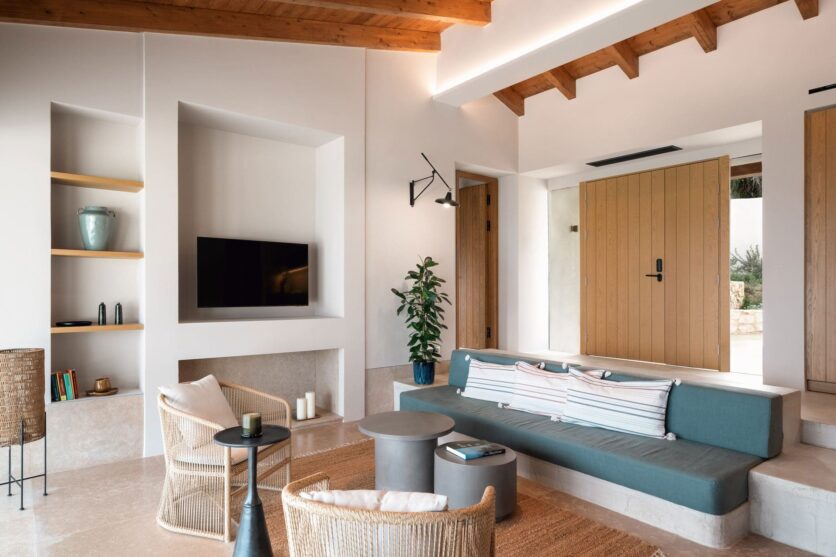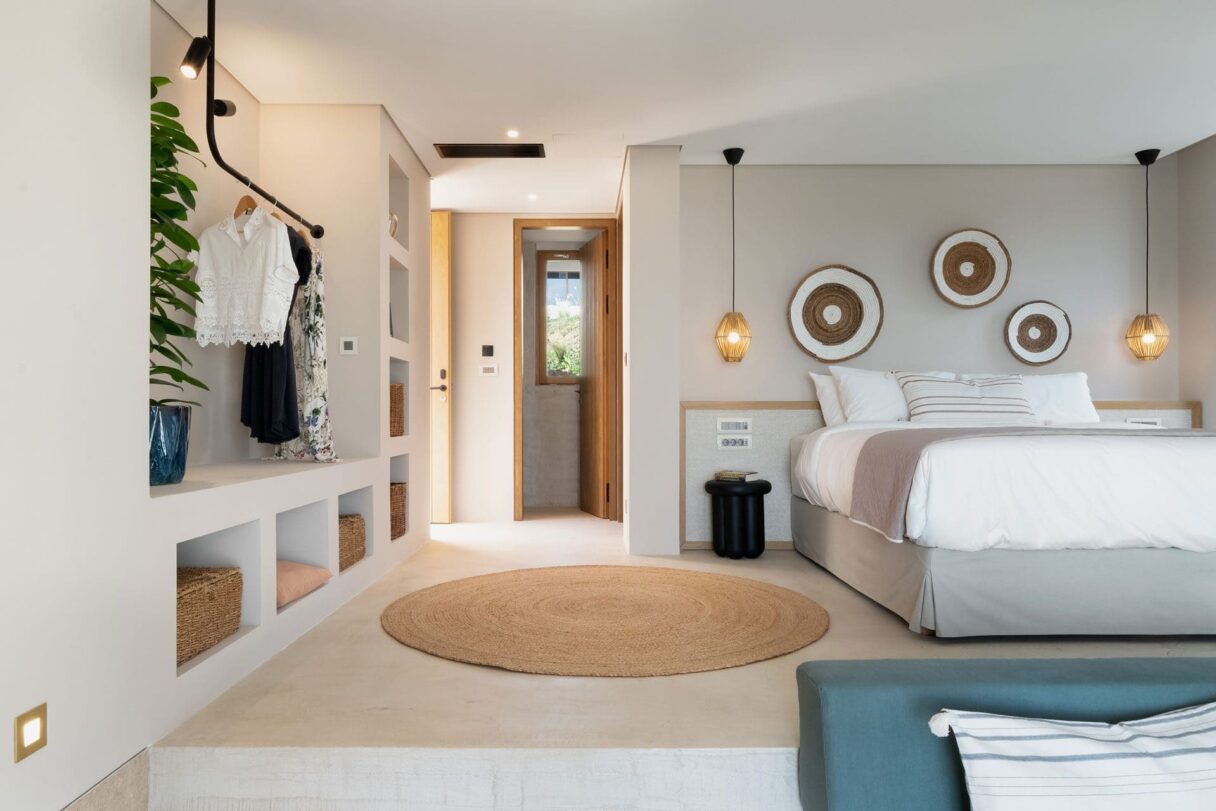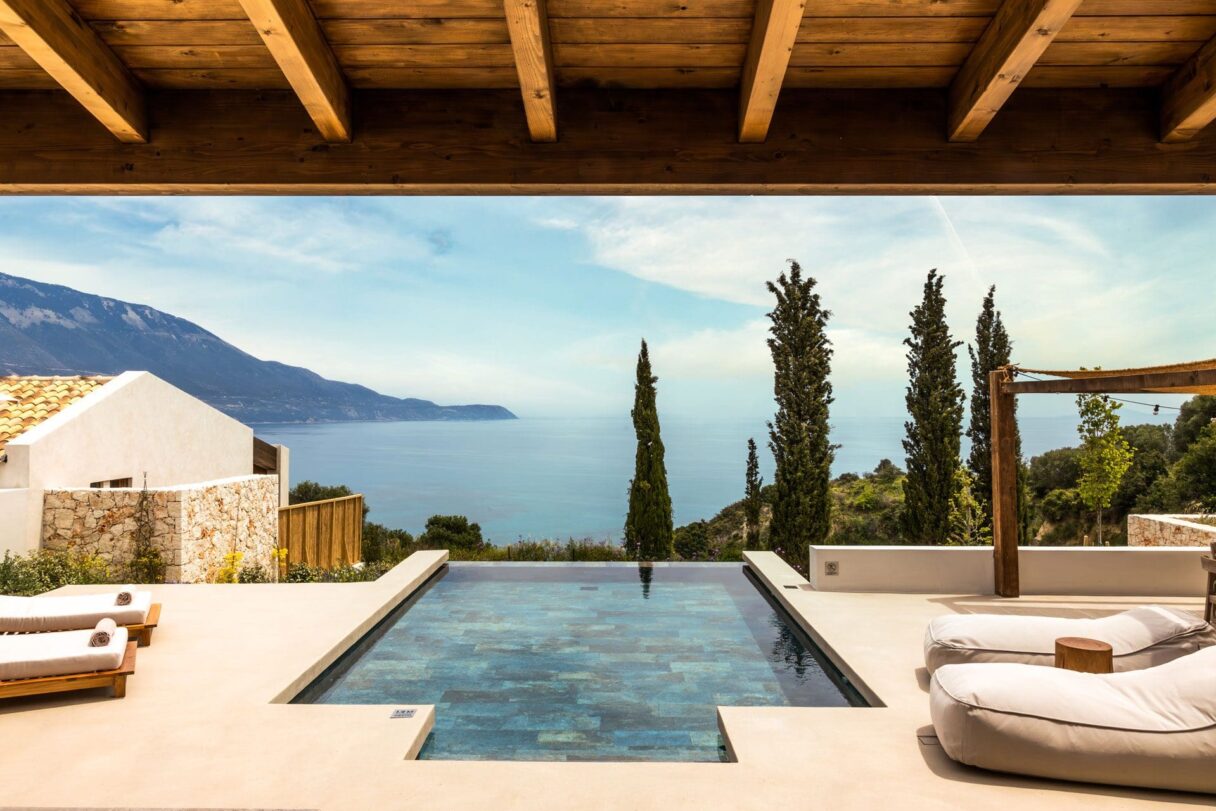The Ionian Sea contains very little solid matter such as plankton and mud. The water is also highly stratified, meaning the top and bottom don’t mix due differences in temperature. Plus, there are numerous sulphurous caves in the area, and when the sea is rising, this sulphur radiates. At least, these are a few explanations that Google gives for the colour of the water surrounding Kefalonia, which is an almost-electric blue, the brightness of which I’ve never seen the like – not even in the Maldives. It looks artificial, like the fluorescent goo in a lava lamp.
To experience this first hand, most online guides will tell you to go to Myrtos Beach on Kefalonia’s north-west coast – once voted the most beautiful beach in Greece, and considered among the top 30 in the world. But I’ll let you in on a secret. The hairpin road leading to Myrtos is permanently congested with people flocking to the hotspot; I desperately searched for a parking space as the attendant barked instructions at me in Greek (I didn’t understand, but I don’t think he was praising my three-point turn). We did bag a couple of chairs, but failed to bring any flip flops or similar – the beach is covered in stones, and, on hobbling into the sea, I was promptly knocked off my feet by the waves and buffeted about in the shallows for a few minutes before returning, bruised, to the lounger.
You’re better off going to Fteri Beach: the water is still clearer than polished glass, but it’s conspicuously free from the hoards due to the fact that it’s only accessible by water taxi. Or, if the whole ‘secluded cove’ thing doesn’t appeal to you, Antisamos Beach on the other side of the island makes up for what it lacks in picture postcard scenes with docile waves and a wealth of beach bars.
Beyond the beaches, there are few publicised attractions in the south of Kefalonia. It’s a good thing, then, that once you arrive at Eliamos Villas, you’ll have no real desire to leave. Opened last May, the hotel is situated in the unassuming area of Spartià, 20 minutes from the island’s capital, Argostoli. Spartià is pleasant enough, with a quaint mini-market, ramshackle church and clifftop beach bar. But, realistically, you won’t eat, drink or kick back better on this end of the island than at Eliamos.
The five-star collection, which is owned by hotel group Relais & Châteaux, consists of 12 villas nestled among lavender, oregano, thyme, rosemary and basil; the plants are wild, and were already on the property when the land was bought. Villas are covered in terracotta-style roof tiles; inside, the decor is bohemian, and earthy hues, brushed concrete and rattan furniture abound. Each accommodation has its own infinity pool (salt water, as this requires fewer chemicals to keep clean), which appear like dark-green lagoons, while quartz terraces mimic the appearance of sand. Squashy, bean bag-like loungers repose under grass awnings and look out towards the sea and the looming bulk of Mount Ainos, whose summit is regularly obscured by clouds.
If you’re detecting wellness retreat vibes, you wouldn’t be incorrect – Eliamos flirts with the concept, encouraging ‘healthy habits’ without judging you for ordering multiple carafes of wine at dinner. There is deliberately no buffet, nothing processed comes out of the kitchen, and the menu is relatively healthy (holidaying in Greece can become, as we found after leaving Eliamos for an Airbnb, a never-ending carousel of chips and saganaki (fried cheese), so the abundance of fresh seafood, local protein, and zesty salads at the hotel restaurant was a godsend). Yoga and reformer Pilates classes take place on the bamboo-shaded cabana each morning – there is also an outdoor gym, and the spa staff are qualified in sports massage.

The Eliamos project was masterminded by German-born Maike Gruna of Maike Gruna Interiors, who designed the retreat, along with her Australian-Kefalonian husband and his Cypriot college pal. The three of them executed their vision of creating an intimate, ‘village-style’ hotel – almost one of a kind on the island, whose luxury offering is still in its infancy.
This is because Kefalonia came relatively late to the tourism game: prior to the airport’s renovation in 2017, it wasn’t exactly easy for outsiders to get here. Thus, the island doesn’t rely on international visitors, and instead is fairly self-sufficient – there is still a shepherd who herds his sheep past Eliamos every morning, and during olive-picking season, you won’t see another soul in Spartià.

This is a blessing – as anyone who has ever tried to snap a picture of the windmills in packed Mykonos will attest to – but there is a reason why Santorini and Naxos (and, indeed, the Cyclades in general) are so popular. Assos, one of Kefalonia’s main attractions, is pretty, with stepped rows of pastel-coloured houses rising from the glittering water – and Fiskado is rather lovely, with a waterfront boardwalk of cafes, restaurants and ice cream parlours covered in bougainvillea. But you won’t find any whitewashed buildings or cerulean domes here. In fact, most of the buildings are new, or built since the 1950s at least, when an earthquake destroyed almost everything on the island.
What you get in Kefalonia is a macchia-coated coastline in a Mediterranean colourway of brown and taupe. Spindly cypresses punctuate expansive escarpments. Gravity-defying goats cling to sheer rock faces on the side of the road. The ever-present backdrop of that (supposedly) stratified, sulphurous, plankton-free sea. Now, for the first time, there’s the option of a five-star base from which to experience it.
Prices start from approximately £600 per night. Visit eliamos.com.
Read more: The best luxury hotels in Istanbul
Credit: Source link
